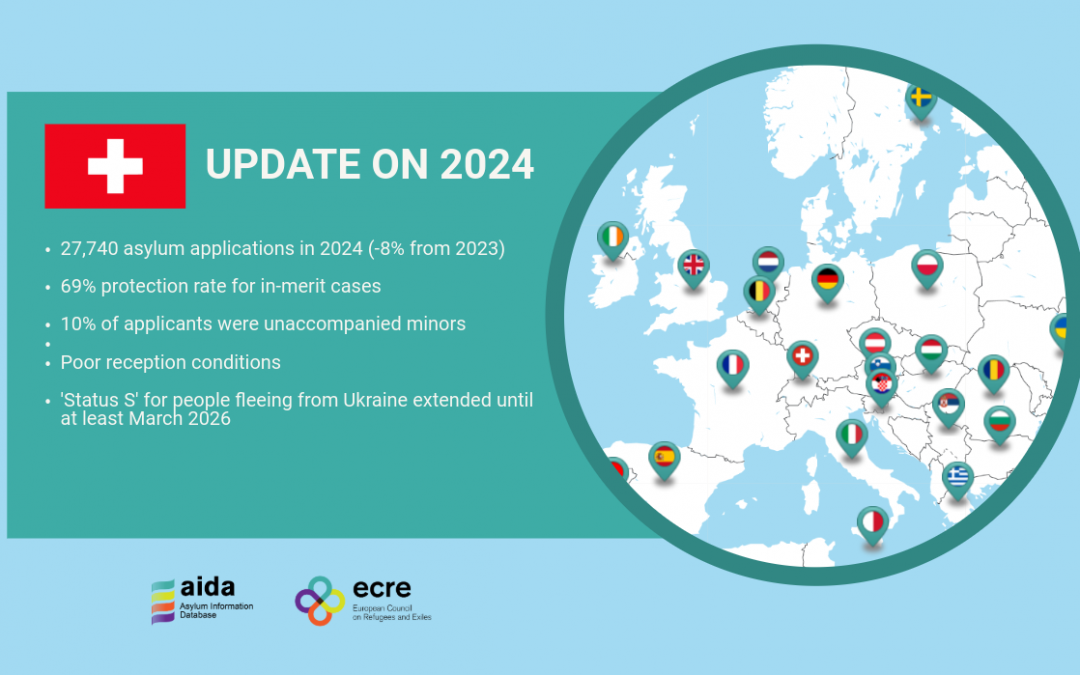The updated AIDA Country Report on Switzerland provides a detailed overview on legislative and practice-related developments in asylum procedures, reception conditions, detention of asylum applicants and content of international protection in 2024. It is accompanied by an annex which provides an overview of ‘Status S’.
A number of key developments drawn from the overview of the main changes that have taken place since the publication of the update on 2023 are set out below.
International protection
- Statistics: In 2024, 27,740 people applied for asylum in Switzerland (30,223 in 2023). The main countries of origin were Afghanistan, Türkiye, Algeria, Eritrea and Syria, and 10% of new applicants were unaccompanied minors. The asylum recognition rate was 47% and the protection rate for in-merit cases was 69%. There were 11,921 first instance cases pending at the end of 2024.
- Policy developments: Switzerland launched a new national asylum strategy process in 2024 and results are expected in summer 2025. In April 2025, the resettlement programme was extended to the end of 2027 but the annual quota was halved to 400 people.
Asylum procedure
- Access to mobile data for identity, nationality or travel route verification: Following regulatory changes that were passed in May 2024, as of April 2025, immigration authorities have been able to access asylum applicants’ mobile phone data when it is the only way to verify their identity, nationality or travel route.
- New 24-hour procedure: A fast-track 24-hour asylum process for nationals from certain countries in Northwest Afria was introduced in February 2024. Legal support under this process is limited.
- Suspension of applications: In 2024, Switzerland temporarily suspended asylum procedures from Sudanese and later Syrian nationals due to changing conditions in their home countries.
- Suspension of Dublin transfers: In 2024, Dublin transfer decisions to Greece for Turkish men were contested in court. A reference judgment from the Federal Administrative Court is expected in 2025.
- Age assessment: In May 2024, the United Nations Committee on the Rights of the Child criticised Switzerland’s age assessment practices and called for both a reduced evidentiary burden on applicants and a presumption of minority in doubtful cases.
- Removals to Afghanistan: Since April 2025, removals to Afghanistan have been deemed possible in specific cases involving healthy, single adult men with strong local ties. However, vulnerable groups remain excluded. In 2024, deportations to Afghanistan resumed for the first time since 2019 (limited to criminal offenders). In addition, courts have clarified that Afghan documents alone are insufficient for age assessments and that risk of future persecution must be assessed independently of past harm.
- Removals to Türkiye: In 2024, the Swiss Federal Administrative Court ruled that removals to Türkiye’s earthquake-affected or formerly excluded regions are not inherently unreasonable but must be individually assessed. In addition, political charges do not automatically justify asylum.
- Readmission and returns: Co-operation with Iraq: In May 2024, Switzerland and Iraq agreed to boost co-operation on returns and reintegration of unsuccessful asylum applicants.
- Inappropriate practices during return procedures: In 2024, the National Commission for the Prevention of Torture (NCPT) raised concerns about return practices, particularly the insufficient protection of children during forced deportations.
Reception conditions
- Living conditions in temporary asylum centres: In April 2024, the NCPT and Amnesty International highlighted poor living conditions in temporary asylum centres, especially in underground civil defence shelters. They identified a number of issues, including overcrowding, inadequate violence prevention, lack of privacy and natural light, and poor ventilation. The organisations also noted that allegations of abuse were insufficiently documented and investigated.
- New and closed asylum centres: A 350-place permanent asylum centre was opened in June 2024. Meanwhile, the State Secretariat for Migration announced that nine temporary centres would be closed by the end of 2024 due to lower-than-expected asylum applications.
- Living conditions for vulnerable applicants: In 2024, the Federal Commission on Migration published two reports which highlighted the negative impacts of living in emergency shelters on children’s development and well-being, and their incompatibility with constitutional and international child protection standards. In June 2024, the Council of Europe Group of Experts on Action against Trafficking in Human Beings (GRETA) reported that reception conditions for trafficking victims remained inadequate.
Content of international protection
- Legal situation of victims of domestic violence: An amendment to strengthen protection for victims of domestic violence under immigration law which was passed by the Swiss Parliament in 2024 entered into force in January 2025. In addition, the Federal Council withdrew Switzerland’s reservation to the Council of Europe Convention on Preventing and Combating Violence Against Women and Domestic Violence.
- Access to apprenticeships: Since June 2024, young unsuccessful asylum applicants and undocumented people have been able to apply for apprenticeships after only two years of compulsory schooling in Switzerland (down from five).
Status S
- Statistics and prolongation: 16,616 people, including 16,418 from Ukraine, requested temporary protection in 2024 and 9,272 of them were granted temporary protection status. In September 2024, the Federal Council decided that ‘Status S’ would be maintained until at least March 2026.
- Restriction of scope: In December 2024, the Swiss Parliament decided that, in future, only people from Ukraine who could prove that they come from a contested or Russian-occupied territory would be granted temporary protection. It is not yet clear when this amendment will enter into force.
The full report is available here and the annex on ‘Status S’ is available here.
For more information about the AIDA database or to read other AIDA reports, please visit the AIDA website.

